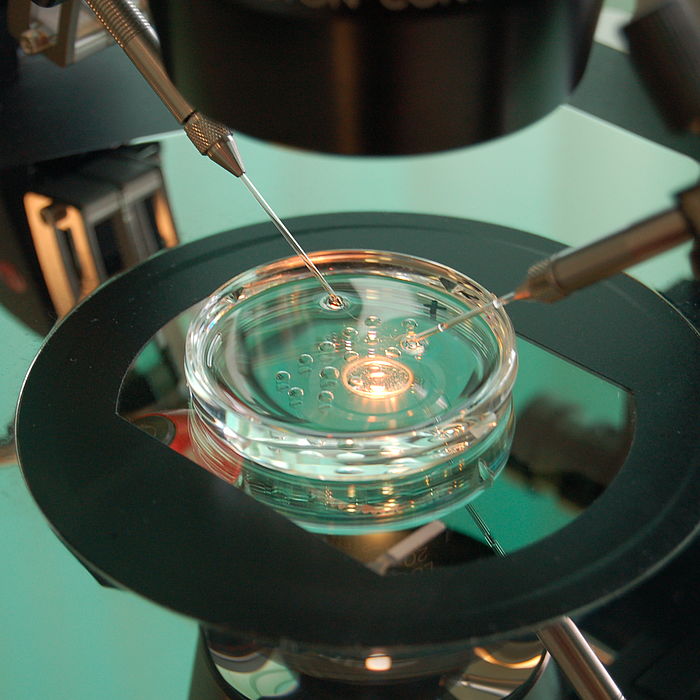The Christian Art Of Adopting Frozen Babies- And Why You Might Want to Consider It

Preamble
Several years ago I did an interview with a friend shortly after his wife gave birth to a ‘snowflake baby’- an affectionate and mildly tragic moniker given to children created in a lab who were frozen and then thawed before being implanted and ultimately born.
Their baby was conceived and fertilized several years ago, but was abandoned by his parents, He was placed in a laboratory freezer where for nearly a decade he wasted away with his siblings, the same fate as an estimated 600,000 more precious souls.
My friend and his wife sacrificed much to rescue him through an “embryo adoption”, where they saved the child from certain death and implanted the embryo in her womb, bringing forth renewed life after years of frozen purgatory.
It garnered much interest, and many people contacted me with poignant stories and pointed questions. Some folk were extremely grieved, having friends and family who had participated in IVF and now were waking up to the horror of realizing that their loved ones had abandoned their babies to be killed- that they had discarded their nieces and nephews in this unholy pursuit.
One woman spoke of how her daughter-in-law had created a child using IVF, leaving the rest of their babies in limbo. She asked if we knew anyone who would consider an embryo adoption so she could see her grandchildren one day. She lamented that she would give birth to these herself if she could, but being in her 50s it was no longer possible, and her helplessness was palpable.
Still, others were incensed. They were upset that I would dare hint that they had done anything wrong and vigorously protested the notion that their embryos were real human beings with souls. These were professing Christian women, specifically, and they refused to acknowledge the weight of what they had done.
But by far, the biggest category was those who had never heard of embryo adoption before- otherwise known as “snowflake adoption” due to the embryos being frozen and having to be thawed- and were curious to know more, and even whether this was something their family could do, as a means of fulfilling the biblical mandate to rescue those being taken away to death and hold back those staggering towards the slaughter.
Here’s all you’d ever want to know.
The Interview
Q: When did you first hear about embryo adoption, and when did the first serious conversations with your wife start taking place, asking “should we as a family do this?”
We first heard about embryo adoption from our friends who gave birth to twins that were frozen for 11 years). That was back in 2011 or 2012. It was sometime around 2013 that my wife began expressing interest in adopting children this way, and we began discussing what it would take to be able to do it.
Q: Was your wife on board the whole time, or was this something you had to convince her of?
Actually, my wife was the one who had to continue to press me about it. She would talk about it, but I just kind of thought about it as something other people were able to do but not something that would really ever be possible for us. I didn’t know how we could do it financially, she had her tubes tied after our last child, she had three c-sections already, and it just seemed like a huge mountain to climb in my mind. But she was faithful to begin looking into options and places to begin and to continue to gently press me about it. Finally, we decided to save a large portion of our tax return one year and that was the beginning of God providing financially for the whole thing.
Q: What made you decide to choose embryo adoption vs traditional adoption?
Well, we actually plan to adopt traditionally sometime in the future, so we haven’t actually ever decided against it. But we were intrigued by the Baker’s testimony regarding embryo adoption, and then some other Abolitionist couples we were close to adopted embryos (unfortunately, neither of them brought children to term), and we just saw how great a need there is and how disregarded these “unknown millions” are. So we decided to take our light and let it shine in the direction of the IVF industry and the orphans that existed as a result of it.
Q: How did your children react to your choice, as well as the rest of your extended family?
Our children were excited and completely accepting of the idea from the moment we told them. But they are used to being around Abolitionism, and so it didn’t really seem all that outlandish to them. They love babies and were excited to have another little sibling. Our extended families were totally unaware of the fact that this was even a thing. So they had a lot of questions, some concerns (which we addressed), and ended up being supportive overall.
Q: How did you decide to choose which children to rescue? Did he have several siblings? Did you flip through a dossier with information on the parents and his genetic dispositions?
Actually, God chose these children for us. Some fertility clinics do have books of embryos to choose from, with short bio of the parents (such as GPA, career, eye color, nationality, height, weight, medical background, etc.). However, the clinic we adopted from does not have lists and lists of donated embryos. In fact, there can be up to a two-year wait for adoptive parents at the clinic we chose. When we got on the waiting list there were 5 couples ahead of us waiting for available embryos to adopt.
There had just been three sets of two embryos (a total of six) donated to this clinic (from former clients). Two sets had been adopted out prior to us getting on the list, and two embryos were left. The five couples ahead of us all passed on the two we adopted because they were African American, and these couples did not want African American children, so we jumped straight to the front of the line. We were willing to rescue any children that were available for rescue.
Q: Has it been strange choosing to give birth to a child that is not biologically your own? Have you thought differently about him or had differing affections towards him compared to your other children?
We had very little information about their biological parents, so it has always been a toss-up regarding what these children might look like. With your own children, you expect that they will have many or most of your features and look somewhat like their siblings. We had no idea (not that it mattered, but it was very exciting to wonder about it). I can say without the slightest doubt that we have loved these children we adopted to an equal degree as our own. There hasn’t been even a hint of partiality in our hearts between our differently conceived children.
Q: In a few short paragraphs, what does the process of embryonic adoption entail?
It starts off with the application and initial medical history, choosing embryos, legal transfer of rights of embryos before a judge (depending on the state what this entails varies), lab work of husband and wife, determining the wife’s last day of menstruation to figure out a start date of the transfer cycle.
You begin birth control pills to regulate the woman’s cycle, lupron injections for several weeks in the stomach, a trial transfer to make sure there aren’t any unforeseen obstacles to transfer, which in our case there were and required an additional outpatient surgery, baseline check to determine uterine lining thickness, which determines transfer date, Progesterone injections in the hip, both injections administered by husband, and estrogen patches which lasted at least until the pregnancy test.
If positive, injections continue until about the ninth week of pregnancy, about ten weeks total. They thaw the embryos the morning of the transfer (5-6 days after uterine lining is where it needs to be) and praying that they are all still alive. If not, the whole process has to start over from the beginning.
Then they transfer the embryos through a catheter through the cervix and wait for a pregnancy test a couple of weeks later. If the test is positive, daily Progesterone injections are continued for about eight more weeks. A second blood test is required to make sure the pregnancy is progressing (if the HCG numbers do not double daily this likely means you miscarried after implantation).
The whole thing is both physically and emotionally draining on both parents, but especially the mother. In our case, we had to drive back and forth to Tulsa from Norman, about a 3-hour round trip. Injections had to be administered each day at the same time, which sometimes required us pulling over on the drive back from Tulsa and do the injection on the side of the turnpike. One of our children did not survive after implantation (our daughter named her Ruth) and our positive pregnancy test was bittersweet when the Endocrinologist told us.
Q: What is cost/price difference for doing a snowflake adoption vs a traditional open/close/oversees adoption?
Our total cost was $12,000 which included an extra $2,000 surgery to dilate my wife’s cervix due to scar tissue interference from previous c-sections. To break that down, there was a “package deal” that was a total of $5800. But we had a $500 legal fee, $850 trial transfer fee, costs of medications around $2500-$3000, plus labs and initial clinic visits before the package deal kicked in.
If foster-to-adopt parents do so through DHS, the adoption is essentially free. Adopting from a private agency can run $8,000-$40,000 after attorney fees, counseling fees, medical fees, etc., and to adopt overseas you will likely pay no less than $30,000 (for both legitimate and illegitimate fees to corrupt governments and orphanages). But I would never discourage adoption by any of these options. Adoption is needed in all of these areas.
Q: Do children born through IVF and frozen for long periods have a higher risk for congenital disabilities and abnormalities than babies conceived the natural way?
After the thawing process, it is observed that there is often cell loss or cell degradation. I’ve seen people talking about “our embryos only had 10% cell degradation/loss.” I was reading on the Genetics and IVF Institute website, and it stated that embryos thawed that maintained greater than 50% cell viability (or retained 50% of its blastomeres) is considered to be an embryo that has ‘survived. Less than 50% is considered to have “partially survived.” The lower the cell degradation rate, the better chance of survival until implantation.
As far as birth defects are concerned, there is a greater risk of low birth rates and premature births with children conceived through IVF. My son was premature due to Placenta Previa, which is also more common in IVF-conceived pregnancies. There is also a greater risk of multiple births, such as twins, triplets, etc., which also causes lower birth weights in children. This information is from the Mayo Clinic website.
It is hard to determine whether birth defects resulting from children born through IVF are caused from the process itself or from the infertility of the woman (although since infertile women aren’t really supposed to be getting pregnant, the use of IVF to do so would be a factor in any child conceived having birth defects IMO). This article in Time Magazine suggests that birth defects are higher from IVF births (but they admit it could be due to fertility complications in the mother). So, all that to say, there are conflicting studies out there and the jury is still out.
Q: If in-vitro is the process that helps families have babies who are otherwise infertile, which then brings them great joy to have a child that is their own flesh, why is this a bad thing?
IVF is sinful for many compounding reasons. First is that we have a great need for parents to adopt already existing orphans. IVF says, “I will go out of my way to ignore these orphans in order to unnaturally have my own flesh and blood children.” So, the IVF industry actually discourages the adoption of already-born orphans in the world.
Second, IVF unnecessarily endangers human beings. They are created in a petri dish, and the “leftovers” that survive or are not weeded out, are frozen in liquid nitrogen to -196 degrees. If they were frozen prior to the newer freezing method called “vitrification” (a flash freeze process), they could have as low as a 50% chance thaw survival rate. With vitrification, it is claimed there is as high as a 90% survival rate. But, needless to say, freezing humans you have unnecessarily created, with a good chance of death, is inhumane and unethical.
The IVF industry also dehumanizes these pre-born children by treating them like disposable commodities. They create large numbers of embryos, knowing that most of them will not survive (either through intentional discarding or unintentional death through freezing or miscarriage). When the parents and Doctors learn that one embryo implanted but the other one or two died, they celebrate because that is all they really expected and were hoping for.
Suppose parents have any kind of history of genetic or health defects themselves. In that case, they can opt for PGD and/or PGS testing, which tests the embryo (by taking a portion of it which can result in its death) and testing it for recessive genes that may result in that embryo being born with whatever disease the parent has. If the embryo tests positive, they are simply destroyed and “better grade” embryos are chosen for transfer and/or freezing.
There are other kinds of testing that are done as well. When we filled out our paperwork, we filled out the same paperwork as parents coming for IVF. On one of the pages were the options we wanted for any “leftover embryos” after a successful cycle. This page did not apply to us since we were not creating any embryos but instead rescuing the “leftovers.” The three options included donating the remaining embryos, destroying them, or donating them to scientific research, which results in their destruction.So even if a couple decided that they were going to only create as many embryos as they were willing to have transferred into her womb without freezing any of them, it is still unethical. Why? Because you are ignoring orphans already among you. You are unnecessarily legitimizing and funding the IVF industry, which in the majority of cases does most or all of the above practices.
Recent studies have shown that doing fresh transfers (transfers of embryos without freezing them) may actually be more dangerous for the embryos because they are being introduced into the uterus, which may become irritated and inflamed from the egg retrieval process just days before, and therefore unnecessarily endangering your children. This is in part because an irritated and inflamed uterus will expel the embryo rather than allow him to implant.
And lastly, as stated above, the IVF industry not only discourages the adoption of already existing orphans but is responsible for creating hundreds of thousands of new orphans; it is an orphan-making industry.
Q: Why should we consider embryos to be human beings? Why would you equate discarding or freezing embryos to be no different than having an abortion?
Human embryos are human beings in the same way that human fetuses, human infants, human adolescents, human teenagers, human adults, and human seniors are human beings. Each of these descriptions is merely descriptions of the human stages of development. None of them speaks to the ontology of the being. Therefore if any humans possess human rights, based upon the fact that they are human, then all humans must possess them, regardless of their stage of development, abilities or inabilities, or any other arbitrary standards or qualifications.
But that begs the question, and we must go deeper. Why do humans possess rights at all? Why is human life more dignified than other life? This is a theological question with a theological answer. The Bible gives us that answer. It is because we are made in God’s Image (Genesis 9:6). God demonstrates the value of His image-bearing creatures by sending His own Son to become one of us (in the womb of a virgin), in order to redeem us from our sin, separation, and judgment of God. Our value is so great in God’s eyes that is cost Him the life of His Son.
Q: What do you think the Christian and the Church’s obligation should be towards our 600,000 frozen pre-born neighbors? What can we do?
First, pastors and teachers should start shining the light onto the evil of IVF rather than ignoring it and allowing the majority of Christendom to remain in ignorance about it. I believe there really is much ignorance here. Most Christians who know anything about IVF see it as a pro-life thing. After all, it is the pursuit of having children and making families. Most do not see or know about the dark underbelly of this practice.
Secondly, when Christians begin to become educated about it, when it is preached against as sin and discouraged as sin, they as individuals need to verbally and actively oppose it in the same way and to the same degree they should oppose abortion.
Thirdly, we should view these pre-born children, imprisoned in freezers, the same way we view already-born children who have been orphaned by their parents (although, I hesitate to say this because I don’t think Christians currently view born orphans rightly, evidenced through the overwhelming Christian inaction in fostering and adopting them or in opposition to abortion). They should begin thinking through how they might go about rescuing these orphans themselves.
Further, we desperately need Christian medical professionals and entrepreneurs, and business men and women, to begin figuring out how we might open clinics that do only embryo adoption and have no participation in IVF, but rather are a visible and vocal reminder of the evil of the IVF industry. This is something that has become a vision for some Abolitionists already.
Editor’s Note. This interview was lightly edited for clarity








My wife and I are currently 8 months pregnant with our snowflake baby.
Google paying an unbelievable profit from homegrown 6850USD every week, this is magnificent a year past I was laid-off in an absolutely horrendous monetary framework. “w many thank you google consistently for gift the ones rules and by and by it’s miles my obligation to pay and rate it with one and all ..
appropriate here I began … … … .. http://www.richsalaries4u.blogspot.com/